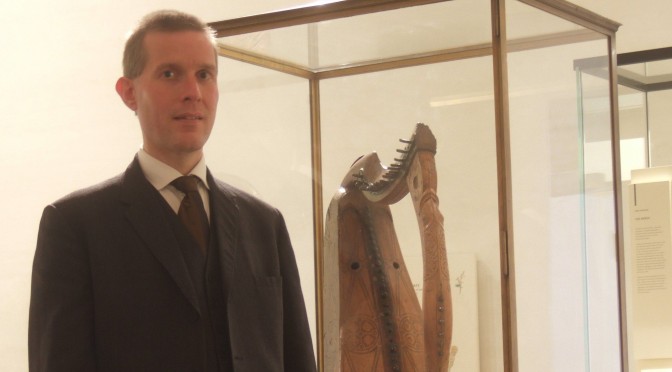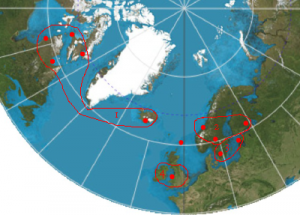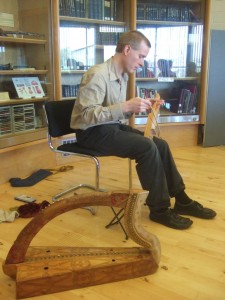I am working hard this week, preparing for three events in three days. On Saturday I am in Dundee; on Sunday in St Andrews and on Monday in London.
Tag: bowed lyre
Bowed-harp workshop
Yesterday I was in Edinburgh to present my “bowed lyre workshop” at the Northern Streams festival.
Margaret 1281 concert at Northern Streams
On Friday 24th April is the first big public outing of the replica Queen Mary harp after it has been seriously reworked inside by Natalie Surina of Ériú Harps. I am going to present my “Margaret 1281” programme of storytelling, song, harp music and bowed-lyre tunes, as part of the annual Northern Streams festival in Edinburgh.
Karelian jouhikko tunes
I have been practicing my jouhikko tunes in preparation for Northern Streams in Edinburgh, (24-25 April 2015). These are the very first jouhikko tunes I learned, as they were on the ‘Reel’ demo tape with Alexander Leonov’s jouhikko playing, which I was given as a gift many years ago, brought back from Petrozavodsk Folk Festival by a friend. Continue reading Karelian jouhikko tunes
Eskimo violin
For my concert last month in the Wighton Centre, Dundee, I tried to find tunes from as many different countries as I could. I was particularly keen to get an Inuit tune, because of the bowed zither traditions from Baffin Island and Northern Labrador.
I read up as much as I could about the various different traditions, and I have updated my Jouhikko web pages to include information on these different traditions. I also made a map to try and show how the different regional traditions of “bowed-harp” playing relate to each other:
The different numbered groups are my attempt to divide the different traditions. Group 1 is the bowed zithers of Canada and Iceland. Group 2 is the narrow-handhole bowed lyres from Northern Scandinavia. Group 3 is the wide-handhole bowed lyres from Southern Scandinavia, and group 4 is the fingerboard bowed lyres from Britain (though there are Continental examples of this type as well)
In the middle I have put Shetland, because no-one really knows what the form of the Shetland gue was. I like to think of it as being part of group 2, but some scholars have argued quite strongly that it should be in group 1.
I managed to get hold of the article by E. Y. Arima and M. Einarsson, Whence and Where the Eskimo Fiddle? published in the journal “Folk”, vol 18 1976. This has some very useful information about the Inuit bowed zithers including photos of a number of museum examples and alsoa photo of a soapstone carving of one being played. However it is not really clear to me exactly how these instruments were played and fingered.
The article also refers to an archive recording from the 1950s, after the tradition had died out and come to an end, when an Inuit person from Northern Labrador made a couple of instruments and played them. I am currently in negotiations to try and get hold of a copy of this recording to listen to it.
Bowed lyre concert
Yesterday’s lunchtime concert with the bowed lyre went really well. The audience was about mid-sized for these events. Everyone shuffled nervously when they saw the instrument lying out beforehand!
I really enjoyed presenting this programme of “national music” from each of the northern countries. I started with the Russian tunes from Petrozavodsk, and then explained a bit about the Finnish collectors and informants before playing some tunes from Finnish Karelia, and so continuing ever Westward, through Sweden, Norway, Shetland, Iceland…
I think the most difficult tune was the Inuit shamanic chant, since it was most alien to my understanding of the ancient European traditions. It was interesting that all of the other music clearly “fitted together” well with similar structures and sonorities, while this one stood out as really foreign. However I think everyone enjoyed the participative and experimental aspects of this one tune!
Towards the end I realised that I had prepared too much material so I missed out a couple of the tunes I had planned to play – and still overran. And then was asked by the host, Sheena Wellington, to play an encore. So I count that as a great success and now I feel I would have no problem putting together a 45 minute or one-hour show based on this idea, a tour of the bowed-harp or bowed-lyre traditions of the old North of Europe.
Bowed lyre concert
On Wednesday, I’m performing for the Friends of Wighton lunchtime concert in Dundee. For something a bit different I thought I would try to put together a half hour recital using only the bowed lyre.
The theme of the concert will be a tour round the ancient north of Europe. I’ll play a tune or two from all of the places that have a bowed lyre or bowed harp tradition – Karelia (Finland/Russia), Sweden, Shetland, Iceland, maybe even Canada, and also some English Irish and Scottish tunes.
The half-hour concert will be held upstairs in Dundee Central Library. The concert is on Wednesday 2nd October, starting at 1.15pm. Admission is free.
More information:
http://www.friendsofwighton.com
http://www.simonchadwick.net/jouhikko
At the Cathedral yesterday
Here’s a photo taken by an attendee at yesterday’s cathedral concert. People were, as usual, most intrigued by the bowed lyre. We had a full house, and the sun was shining. People came to the event from as far away as the west coast, and there was even a visitor from Bergen who appreciated the Norwegian connections in the programme!
Dundee Wighton concert photo
Margaret 1281 concert in Dundee
On Wednesday lunchtime I’ll be presenting my Margaret 1281 programme in the Wighton Centre, in Dundee Central Library. This is always a fun event, the free concert run by the Friends of Wighton on the first Wednesday of every month at 1.15pm.
I presented this programme back in June at St Andrews Cathedral and it worked very well. The idea is to present a dramatic episode of Scottish history in music and verse. All of the six items on the programme have strong connections to Scotland or Norway in the late 1200s and early 1300s.
As well as playing the replica Queen Mary harp, I’ll sing the traditional ballad telling a part of this story, and I’ll also pull out the jouhikko for a bit of old Scandinavian flavour.









